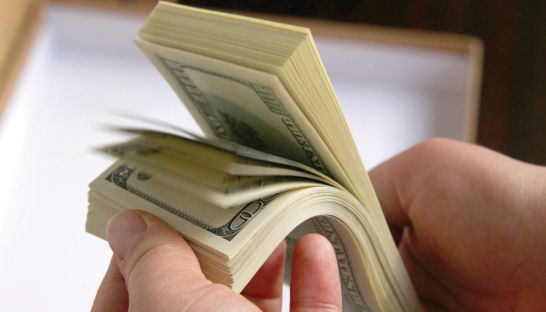The Kingdom’s biggest dirty little trade secret
The Kingdom’s biggest dirty little trade secret
More than $15 billion exited Cambodia in illicit capital flows over the past decade, stripping the economy of money that could have been used for development, a new report shows

A staggering amount of money was funnelled out of Cambodia in shady transactions over the past decade, with more than $4 billion exiting the country illegally in 2013 alone, according to new research.
In a report released this week, investigators from Washington-based Global Financial Integrity (GFI) said they found evidence that at least $15 billion was lost to illicit financial outflows between 2004 and 2013, most of it secretly shifted offshore using a technique known as trade misinvoicing.
The process [see sidebar], where companies misstate the value or volume of an import or export product on a shipping invoice, “allows criminals, corrupt government officials, and commercial tax evaders to shift vast amounts of money across international borders quickly, easily, and nearly always undetected,” the report said.
It is also a notoriously popular practice, according to Raymond Baker, president of Global Financial Integrity, who said trade misinvoicing accounts for over 83 per cent of the $1 trillion in illicit flows leaving developing countries annually.
“While the total value of this trade would not be applied to development programs, the tax associated with this illicit activity could be allocated to various poverty alleviation efforts,” he said. “Curtailing even a small portion of these illicit flows would have a catalytic impact on a government’s ability to address the needs of its most vulnerable people.”
The GFI report highlighted the exponential rise in Cambodia’s trade misinvoicing outflows over the past decade, which increased from $374 million in 2004 to nearly $3.9 billion in 2013 – about a quarter of that year’s nominal GDP.
So how does trade misinvoicing work?
As an illustrative example, Cambodian firm BS Traders Inc agrees to sell a shipment of white rice to US firm Patsy Foods Ltd for $100,000. BS Traders writes up an invoice for the transaction, but to lower its tax obligations or launder dirty money, it puts the sale price at just $60,000. At Sihanoukville port, customs officials lacking either the resources or inclination to verify the dodgy invoice let the undervalued shipment pass.
The dodgy invoice is then sent to Bogus Inc, a shell company secretly owned by BS Traders and based in a tax haven. Bogus re-issues the invoice, but this time with the agreed-upon amount of $100,000, and sends it to Patsy Foods – which receives the shipment of rice from BS Traders and pays the full invoiced amount to Bogus.
Bogus then sends $60,000 – the amount on BS Trader’s invoice – back to the company in Cambodia, and secretly diverts the other $40,000 into an offshore account owned by BS Traders. In this way, BS Traders declares its invoiced $60,000 payment to Cambodian authorities, while skimming $40,000 in untaxed profit on the deal.
Son Chhay, a lawmaker for the Cambodia National Rescue Party, said the trade-based money laundering scheme is made possible by the fact that traders are responsible for writing their own invoices.
“Faking invoices is an easy way to bring money out of the country and can be done through trade in goods or services, and by individuals or as company investment,” said Chhay. “There are two reasons to do that. First is to avoid paying taxes, and second is to send black money overseas under the illusion of investment or trade.”
This is not a trickle, it is a torrent of illicit capital outflows, said Son Chhay, a lawmaker for the Cambodia National Rescue Party.
“The money we lost [in 2013] was more than the entire national budget,” he said after reviewing the report. “It is a huge loss for the nation.”
But it turns out the illicit outflows from misreported trade activities are only the tip of the iceberg. GFI found an even higher volume of misinvoiced inflows – money secretly brought into the country to be laundered.
Together, more than $30 billion in dirty money was pumped in or out of the country in the decade up to 2013 by either over- or under-invoicing trade activities.
GFI investigators uncovered the illicit transactions by poring over Cambodia’s bilateral trade data sets, comparing its reported imports and exports to those of its trade partners and noting the discrepancies.
They also searched Cambodia’s balance of payments statistics to identify hot money narrow (HMN) outflows – money that had essentially “disappeared” from the economy.
More than $450 million was spirited out of Cambodia in hot money outflows in the decade ending 2013, much of it via illicit wire transfers from financial institutions not monitored by a central bank, according to the report.
While the research required GFI investigators to extrapolate data, they said, if anything, their figures understate total illicit fund flows as the study only covers the misinvoicing of trade in goods, but not in services.
It also only reports on transactions for which there is a paper trail.
Commerce Ministry officials declined to comment on the report, while customs officials did not reply to queries.
But Chhay said the government had a duty to investigate illicit fund flows and identify those involved in these transactions.
“In Cambodia, it is difficult to deal with [illicit capital flows] as the country’s system is loose and corrupted, but we must know who owns this money,” he said.
“I hope the report is a wake-up call for the government to show more interest in the issue.”













